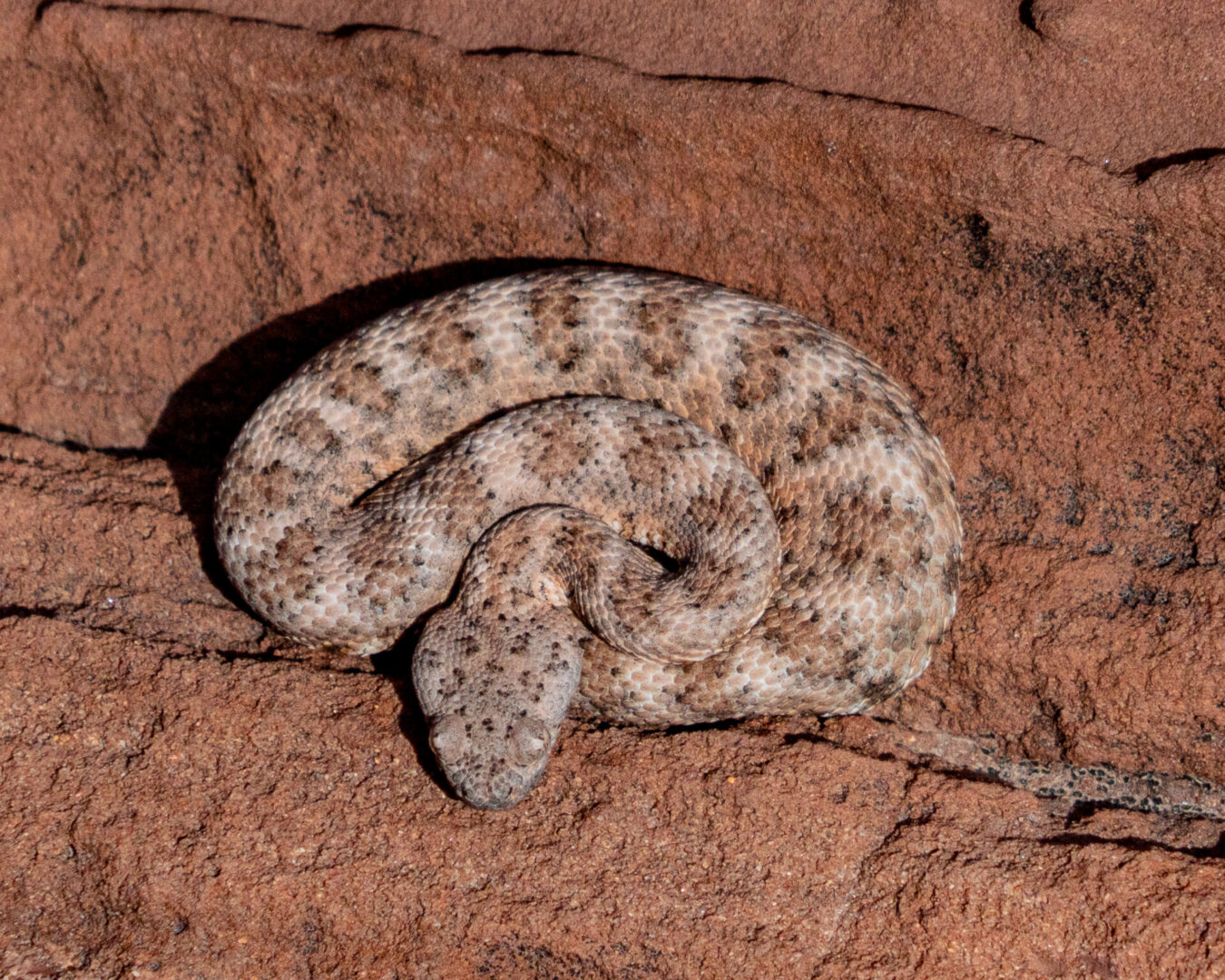The Speckled Rattlesnake

WHAT CRITTER MIGHT RATTLE IF YOU STARTLE IT, BUT THEN AGAIN, IT MIGHT NOT…
You’re more likely to spot a southwestern speckled rattlesnake (Crotalus pyrrhus) in the quieter, drier side of Clark County Wetlands Park, such as the rockier points on and north of the North Loop Trail. This species is relatively shy and doesn’t seek out confrontation. It prefers to lie still, unnoticed, as people and pets walk past. Like other ambush-hunting rattlesnakes, these snakes are more likely to find a nice cubby to hunker down in and wait for food to come by.
Within the last five years or so, the broader speckled rattlesnake species (Crotalus mitchellii) was reclassified, thanks to genetic testing and further scientific study, with the snake’s location playing a larger role in the categorizing. Subsequently, we now have the southwestern speckled rattlesnake as its own species. These snakes are found predominantly in southern Nevada, southern California, southwestern Utah, western Arizona, and northern Mexico.
Named for the pattern of speckles over a lighter base color, the snakes typically take on the color of their environment to blend in, camouflage style. The snake pictured here was taken on the scenic Overlook Trail, accessed from the southeast section of the North Loop Trail. The trail sees very light foot traffic, so this snake was able to enjoy some shuteye in the sun.
“Speckleds” typically grow to two feet in length, with bigger ones up to three. It has elliptical-shaped eyes and keeled or ridged scales. Like all rattlesnakes, it has a triangular head, with large venom glands in its cheeks and moveable, hinged fangs in its mouth, and a rattle on its tail. It uses its special heat-sensing pit organ located between the eye and the nostril on both sides of its head to locate its prey, which is then killed with the injection of a neurotoxin through its hollow fangs. If provoked, the snake may rattle its tail, but at other times it may adopt a “silent” defense, especially when its senses that crawling away would put it in greater danger. Note: this snake is venomous in that it injects dangerous venom into its victim (while a poisonous snake would be harmful to touch or eat). Also, even a dead rattler can inject venom if its jaws reflexively open when touched.
Speckleds are carnivores. In the Park, they eat small mammals (such as rodents), lizards, toads, rabbits, and occasionally birds. They are primarily nocturnal, though in cooler weather they may be diurnal and less active. They tend to mate when coming out of hibernation in the spring. When seeking a mate, males will follow the scent trails provided by females. When a male finds a willing female, he will move his body alongside hers and “mate.” Mating may last several hours, then the male retreats. While most species of snakes are what is called oviparous, meaning they reproduce by laying eggs, rattlesnakes are ovoviviparous, meaning they give birth to live young, called neonates. It’s common for a female snake to give birth to eight to ten young ones at a time.
Neonates are typically abandoned by their mothers after a week, and the new snakes will first shed their skins around that timeframe. They will add the beginnings of a rattle — a button-like segment that forms the base of the rest of the rattle, which is added to with each successive shedding. These young snakes are well-equipped for survival, with venom as potent as their adult counterparts. Unlike mammals and birds, rattlesnakes do not stop growing when they reach adulthood. Instead, they continue steady growth, accompanied by periodic shedding, for their entire lives.
While I have hiked many trails in our area, I have only seen one speckled rattlesnake sleeping in the branches of a creosote bush. But I have seen the resulting aftermath of the birth of rattlesnakes in rural New York State. Late one spring, when most of the wintry snow melt was gone, I began mowing the lawn sections of our ½-mile long driveway. I was using a simple, gas-driven push-type lawn mower to clean up some of the tight areas near the mailbox and large boulders where a larger sit-on mower couldn’t maneuver. I came upon a medium-sized rock that had popped out of the soil as a result of the spring thaw. To mow the area to my satisfaction, the rock had to be moved. Using a crowbar, I pried it out of the soil. Well… I uncovered a population of at least 10 timber rattlesnake (Crotalus horridus) babies! They wiggled and squirmed, looking to me much like the image of the head of Medusa, covered in snakes. I carefully placed the rock back where I found it and moved my activities to another part of the driveway.
As the weather gets warmer, please stay alert on and off the trails in the Park. Be particularly mindful of where you place your hands and feet, especially in rocky or brushy areas, to avoid potential encounters with rattlesnakes. If you do get bitten, treat any rattlesnake bite as a medical emergency and seek help immediately.
-By Constance Carlson, Director of Communications; photo by Dinorah Arambula, Dinorah Arambula Fotographia
Please enjoy these YouTube videos:
Birth of Crotalus pyrrhus – Southwestern speckled rattlesnake
Southwestern Speckled Rattlesnake #2
